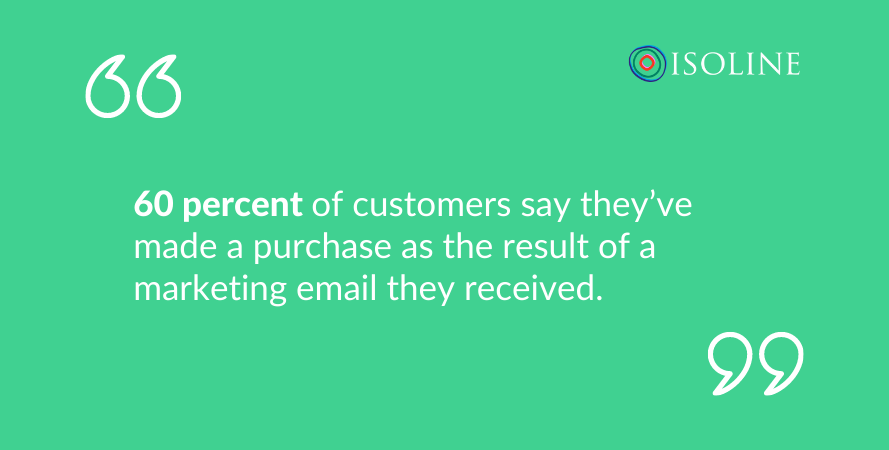Email is still one of the best ways for businesses to engage their target audience. Reaching prospects with content relevant to their position along the buying process yields 73% higher conversion rates.
And email is a great way to go about delivering that content. But the value of email doesn’t stop there. Email has a return on investment (ROI) of $36 for every $1 spent, higher than any other form of marketing. A targeted email drip campaign, then, is a crucial component of any inbound marketing strategy, able to nurture prospects through the process of education and relationship building.
Sounds great, but how do you create a nurturing campaign that makes your prospects hit “open”? Here are our six tips for creating that killer nurturing campaign.

1. Speak to your sales team
Your sales team is a goldmine of information. Forget about keeping marketing and sales separate and collaborate with them on the campaign.
They will know the most about what it takes to convert customers and the conversion rates of leads coming in from your nurturing sequence. Run your campaign plan by them before it’s launched and check in to see if they have any feedback. You can then adjust your emails accordingly.
2. Segment your audience
Nurturing emails are most effective when they are personal and relevant. There’s no one-size-fits-all solution. You wouldn’t have a meeting with an entire company just in the hopes of talking to a C-suite.
But you don’t always have that information handy, nor do you have the time to research each person in your 10,000 strong list.
The solution? Segment your contacts by their actions.
For example, did a lead download a white paper on a specific topic or offering? Segment.
Did someone sign up for your newsletter after a recent product launch? Segment.
Perhaps your product or service appeared on a webinar or at a trade show, and people got in touch with your sales team? Segment!
Remember, your nurturing emails need to resonate with contacts depending on their journey down the sales funnel. Each stage will require different information, and it’s essential to plan for this accordingly.
3. Give your emails a personal touch
We all know that personalisation matters. And there are a whole host of ways to personalise emails. From obvious steps such as personalising the first name field to sending emails specific to their attributes and actions they’ve taken.
One underrated technique is to humanise your brand by adding a face to the sender’s name. This approach was A/B tested by Hubspot, as you can see below. In one email, they signed off as the company, and in the second, they signed off as a member of their marketing team.

They discovered that the personal email generated more opens and clicks than the email from the company.
Ultimately, you want your emails to sound conversational. Customers respond better to emails that look and feel like an actual human wrote them.
4. Marketing automation is your friend
Automated emails are triggered based on a user’s action or series of actions. For example, a welcome email will be sent to users when they sign up for your newsletter. Aside from increasing your workflow efficiency, automating your emails brings you closer to customers.
It enables tailored content to guide each user through the sales journey. Take another example: if someone downloads a whitepaper, it’s a good indication that they are around the middle of the sales funnel. A few days later, you could send content closer to the bottom of the sales journey, encouraging them to book a demo or contact a salesperson.
Sending the right content to the right person at the right time is the key to effective nurturing email campaigns. Using intent data – datasets that show what an individual is interested in and, therefore, what they are likely to do, say or buy next – makes this an even more intelligent outreach process. A simple free option is Gmass. Gmass is a powerful business marketing tool that allows you to run mass email campaigns from Gmail, manage responses, create recipient lists, and more. There is a free version but also paid options if you want to check out Gmass pricing.

5. Testing…
Launching a nurturing email campaign doesn’t mean you should fire and forget. Continuous tweaking and adjusting based on your email statistics and intent data is a must for any email nurture campaign to be effective. Before sending emails to your segments, ensure you use a group of testers for different email clients. For example, your test email might look fine on Outlook, but an image might not display properly on Gmail.
Use A/B testing to send variations of your emails to different contacts. Test variations of subject lines, CTAs, headers, and images and see which combinations impact your engagement metrics.
Test out different days and times to send out emails. There’s no perfect time or day, so make sure you experiment. And keep testing to maintain a well organised and active list of warm leads. You don’t want your contacts to go cold. If your list does start to go off the boil, check out our blog on bringing your email lists back to life.
6. …And touchpoints
Lastly, nurturing email campaigns are only as good as the supporting tactics that make up the overall marketing strategy, like social or paid search. For email, the more information and data you have along these touchpoints, the more meaningful and engaging your email nurture campaigns will be.
Slow and steady wins the race
Creating a nurturing email campaign takes significant planning and content to be effective. But once you’ve done all the heavy lifting, the entire process can be run with ease, with favourable ROI compared with other strategies.
Want more help? Download our free lead nurturing campaign workbook today.



